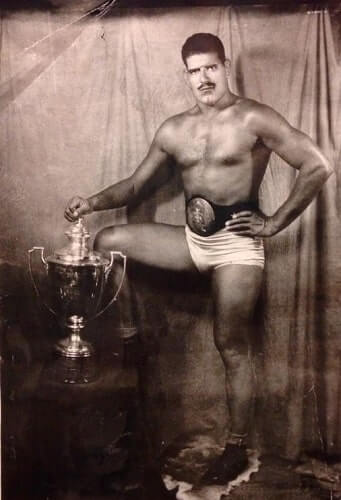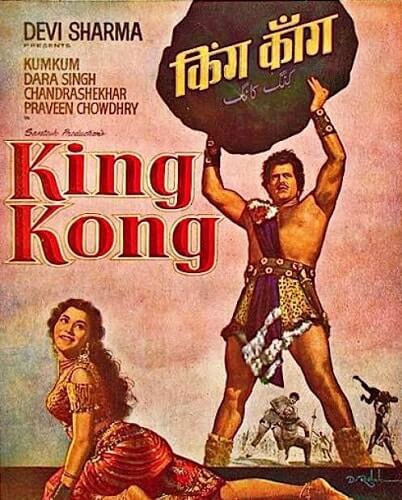His life seems right out of a Bollywood potboiler. Pulled out of school and put to work on his family’s agricultural land, he is married off young but frustrated at the bickering between wife and mother, he goes abroad to make a career. In a few short years, he is not only a celebrity sportsman and a popular film star, but a cultural icon.
This was the life of Deedar Singh Randhawa, or Dara Singh, as we better know him.
Capable of tossing villains around without breaking a sweat, stopping airplanes with his bare hands, and chasing criminals to the moon in his onscreen persona, and in real life, boasting of a long bout as an unbeaten wrestler in both the amateur and professional circuits, and once lifting up a portly Raj Kapoor in his trademark “aeroplane” spin move in public, his very name was synonymous with sheer strength and masculinity for generations of Indians.

But Dara Singh’s journey from a farmhand to cultural icon – especially when he became the “popular face” of two of the strongest Indian mythological heroes (Hanuman and Bheem), as well as many other strong men or folkloric heroes, was no means smooth or even assured. It was raw determination, unflinching commitment, and a true champion’s trademark grit that made him what we know him as.
Born in a Jat Sikh family in Dharmuchak village of Amritsar district in the (undivided) Punjab in 1928, his childhood was not very comfortable — brought into sharp relief when the five-year Dara, or Deedara then, accompanied his family to the Golden Temple and listened avidly as his grandmother recited their family history down to their rather straitened present-day circumstances.
Most importantly, he was not born a strongman and was liable to be bullied, until he – like the Hanuman he would so memorably portray on both the big and small screen – was made aware of his strength, as per his autobiography (originally published in Punjabi) Meri Atmakatha and Seema Sonik Alimchand’s masterful biography Deedara Aka Dara Singh! (2016)
With his first marriage a fiasco, he decided to go overseas in 1947. His journey to Singapore had an unpromising start as he swerved from his moral compass on the sea voyage, but recanted and made amends in time. In Singapore in 1947, he worked in a drum-manufacturing mill and began his wrestling training under Harnam Singh.
Back home, after a few years, he competed in the ‘Rustam-e-Hind’ tournament in 1954 and won by defeating Tiger Joginder Singh in the final and in 1959, won the Commonwealth Championship by defeating George Gordienko at Calcutta.
Amid this, he also drifted into films, debuting with a cameo in no less than Dilip Kumar-Madhubala’s Jane Eyre inspired Sangdil (1952) and was then seen as a wrestler in the Kishore Kumar-Vyjanthimala starrer Pehli Jhalak (1954). However, after this, there was a lull and it was only in the 1960s that he made his mark in the industry.

From 1963, he did several B-grade films – costumed dramas, dacoit films, and even, science fiction. Most of them (16) were with actress Mumtaz, who with her winsome charms made a successful pairing with his machoism. While most of these are obscure – Faulad (1963), Rustom-E-Baghdad (1963), Chand Par Chadayee (1967), and so on, they are a vital indication to what the common people preferred. And they must have been successful for Dara Singh to get Rs 4 lakh per film.
In the process, Dara Singh also went on to play several heroes of Indian and global folklore – the Biblical strongman in Samson (1964), early 20th-century Punjabi outlaw Jagat Singh Virk aka Jagga Jat in Jagga (Punjabi, 1964), the jungle hero in Tarzan comes to Delhi (1965), Alexander the Great in Sikandar-e-Azam (1965) – opposite Prithviraj Kapoor, who had played the role himself over two decades back, now as King Porus, Emperor Akbar-era desperado Abdullah ‘Dullah’ Bhati, of the Lohri song fame, in Dulla Bhatti (Punjabi, 1966), Sultana Daku in the 1972 film of the same name, Daku Daulay Khan in Dukh Bhanjan Tera Naam (1974), among others.

On the other hand, he began his foray into depicting the strongmen demigods of Hindu mythology and religion by playing Bheem in Babubhai Mistry’s Mahabharat (1965) (with one-time grappling partner Tiger Joginder Singh as Hanuman!). He possibly played the wind god’s son for the first time in Veer Bajrang (1965), then in Bajrangbali (1976), the most famously in Ramanand Sagar’s iconic TV serial Ramayan and then in B.R. Chopra’s TV series Mahabharat and finally in TV series Lav Kush (1997).
For good measure, he also played Hanuman’s earthly father Kesari in TV serial Jai Veer Hanuman (1995), opposite his son Vindu Dara Singh, and then, Bhima’s son Ghatotkach in Gujarat film Maya Bazaar (1984).

But that was not all – he also played Lord Krishna’s irascible elder brother Balram twice in Balram Shri Krishna (1968) and Krishna-Krishna (1986), and Lord Shiva thrice – in Tulsi Vivah (1971), Hari Darshan (1972), Har Har Mahadev (1974), and then fervent devotee, Dyanu Bhakt, who had cut off his own head to sacrifice to the mother goddess and was resurrected in Bhakti Mein Shakti (1978), and Dhyanu Bhagat (Punjabi, 1978).
And then, in Bollywood, he is known for his cameo as the circus strongman in Raj Kapoor’s magnum opus Mera Naam Joker (1970) – Kapoor, to whom he was close, had just called him one day to tell him he was in the film, and returned the favour by appearing in his Mera Desh Mera Dharam (1973), as the strongman whom Rajesh Khanna convinces to deal with some hoodlums in Anand (1971), the hero of Hum Sab Chor Hain (1973) with oldtime baddie Sheikh Mukhtar, the real “Mard” in Manmohan Desai’s “Mard”, and many more.

Dara Singh was also close to Balraj Sahni and convinced him to act in his Nanak Dukhiya Sub Sansar (1970) – one of two Punjabi films this talented actor did in his entire career.
Retiring from wrestling in 1983, he was active till his last, continuing to act in films and TV serials for the nearly next three decades with highlights being Shah Rukh Khan’s boisterous and young at heart uncle in Kal Ho Naa Ho (2003) and Kareena Kapoor’s grandfather in Jab We Met (2007).
He also served a term as a nominated Rajya Sabha member (2003-09) – where he was known for asking questions on education.
However, he could not withstand the ravages of aging and disease, succumbing to a heart attack in 2012, aged 83, capping a life which showcased the effort and spirit needed to become – and remain – a legend.
READ ALSO: Shammi Kapoor and his rocking, reinvented film career




